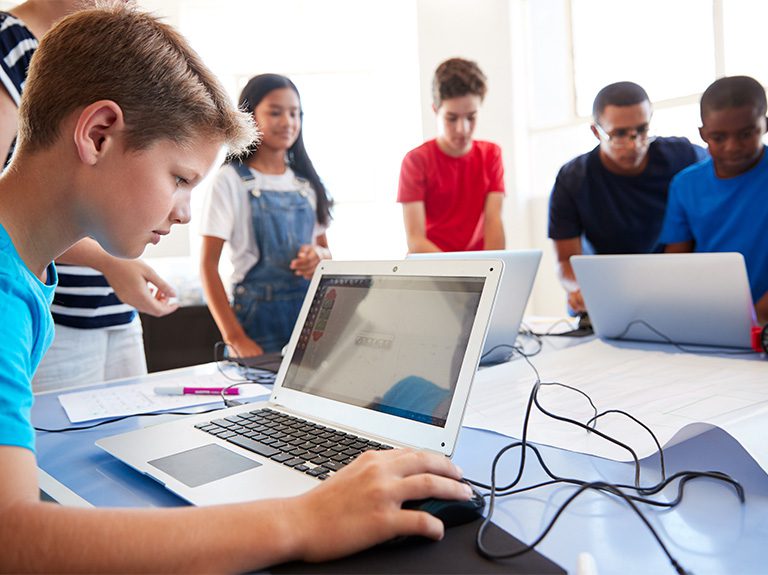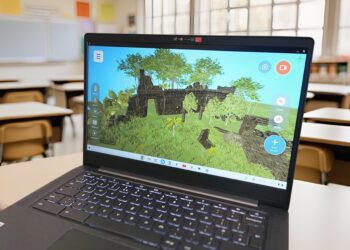Physical (also known as concrete) manipulatives like the abacus or blocks have been basic tools of teaching math since time immemorial. The ancient Romans and Greeks conceived of counting boards and eventually the abacus, and the Chinese abacus that came into use centuries later is thought to be an adaptation of the Roman version. Italian educator Maria Montessori brought manipulatives to early childhood learning over a hundred years ago with great success. Today, the National Council of Teachers of Mathematics (NCTM) recommends the use of manipulatives at all grade levels to teach from NCTM standards: problem solving, communicating, reasoning, connections, and estimation.
Why do we need manipulatives to teach math?

An ancient Chinese proverb says, “I hear and I forget. I listen and I understand. I do and I remember.” Educational research suggests that the most valuable learning happens when students actively construct their own mathematical understanding. The essential abstract concepts can be difficult for some students, especially younger learners. Manipulatives can make an enormous contribution to sense-making abilities for all students—and have been shown to be of special benefit to students who are high-risk, learning disabled, or with limited English proficiency to understand the symbolic language of math.
How are physical and virtual manipulatives defined?
Physical, or concrete, manipulatives are physical objects that are used as teaching tools to engage students in the hands-on learning of mathematics to introduce math concepts. It’s important for children to have a variety of materials to manipulate and the opportunity to sort, classify, weigh, stack, and explore to help them construct their own mathematical thinking and knowledge with Cuisenaire Rods, Base 10 Blocks, and Fraction Circles.
Virtual manipulatives are cognitive technological tools that are a dynamic visual representation of physical manipulatives which can be operated through a computer mouse (or a finger on a tablet) to slide, flip, and turn just like a three-dimensional object. Virtual manipulatives give learners the same opportunity to make meaning and see relationships as the result of their actions, just like a physical manipulative. Although virtual manipulatives have some similarities with their physical manipulative counterparts, as cognitive tools virtual manipulatives have unique characteristics that go beyond the capabilities of physical manipulatives.
What are the differences between physical and virtual manipulatives?

There is some effort on the part of the student to extract the mathematical ideas from interacting with physical manipulatives. In contrast, built-in constraint systems in many virtual manipulatives provide support for sense-making and make math ideas more explicit as the student interacts with the tool. Physical manipulatives don’t provide specific, direct feedback and interaction, while virtual tools react to the learner’s actions, and provide prompts and guidance that help the user focus on the math in the task.
Some virtual manipulatives can be altered, including changing the shape of the onscreen object or marking the object with notations. Virtual manipulatives are readily available with unlimited access to many copies of an electronic object through the click of the mouse—you never ‘run out’ of blocks. Another plus is the 24/7 access to virtual manipulatives, whether they are free or part of a program.
There’s also the ‘fun factor”: students like using technology, find manipulatives easy to use, and enjoy using the computer to explore ideas and information.
What does research say about the use of virtual versus physical manipulatives?

Studies indicate higher achievement and increased flexibility in learning, as well as increased motivation and time on-task. Judy Donovan, in a Tech and Learning article, notes that while virtual manipulatives provide some support for individual student use, as with physical manipulatives, students benefit from teacher guidance to help them use the manipulative correctly and connect to the underlying math.
A 2011 study, Virtual vs. Concrete Manipulatives in Mathematics Teacher Education: Is One Type More Effective than the Other? found that incorporating both types of manipulatives into the instruction of prospective math teachers not only helps them build their own conceptual understanding, but also provides them with sound pedagogical strategies for their future students. The study also found that concrete manipulatives appear to be more effective for building pre-service teachers’ conceptual understanding, with virtual manipulative to reinforce those concepts.
Should you use both physical and virtual manipulatives to improve teaching and learning math?
In the 2011 research study, there was a definite advantage to incorporating both types of manipulatives. The order of manipulative use appears to impact the development of conceptual understanding and the students’ ability to transition to abstract algorithms. Using concrete, followed by virtual manipulatives, is recommended by the researchers. Once conceptual understanding is brought about using concrete manipulatives, the subsequent use of virtual manipulatives seems to facilitate bridging to the abstract. It’s a familiar story: teachers need to make math learning more accessible, engaging, and effective with every tool that’s available, particularly with their own skills.
While the use of virtual manipulatives is new, utilizing manipulatives to support math instruction is a timeless strategy! Education and technology are both changing to meet student needs, and introducing virtual manipulatives can bring a unique support for students as they strengthen their math skills.






